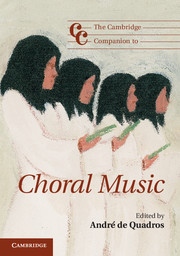Book contents
- Frontmatter
- 1 Introduction: choral music – a dynamic global genre
- Part I Choral music: history and context
- Part II Choral music the world over
- Part III Choral philosophy, practice, and pedagogy
- 15 Globalization, multiculturalism, and the children's chorus
- 16 Exploring the universal voice
- 17 Authentic choral music experience as “good work”: the practice of engaged musicianship
- 18 The making of a choir: individuality and consensus in choral singing
- 19 A point of departure for rehearsal preparation and planning
- 20 Small ensemble rehearsal techniques for choirs of all sizes
- Notes
- Select bibliography
- Index
- Cambridge Companions to Music
20 - Small ensemble rehearsal techniques for choirs of all sizes
from Part III - Choral philosophy, practice, and pedagogy
Published online by Cambridge University Press: 28 September 2012
- Frontmatter
- 1 Introduction: choral music – a dynamic global genre
- Part I Choral music: history and context
- Part II Choral music the world over
- Part III Choral philosophy, practice, and pedagogy
- 15 Globalization, multiculturalism, and the children's chorus
- 16 Exploring the universal voice
- 17 Authentic choral music experience as “good work”: the practice of engaged musicianship
- 18 The making of a choir: individuality and consensus in choral singing
- 19 A point of departure for rehearsal preparation and planning
- 20 Small ensemble rehearsal techniques for choirs of all sizes
- Notes
- Select bibliography
- Index
- Cambridge Companions to Music
Summary
Philosophy
Can anything original really be added to the many volumes already in print containing all manner of earnest thoughts about choral rehearsal technique? Plunging into choral conducting and the teaching thereof after thirty years as a performer, I dutifully purchased various carefully selected tomes about crafting the choral rehearsal, vocal warm-ups, and the like, but soon came to the conclusion that our own ears and ideals were a more important resource.
I was fortunate to work with fine mentors and contemporaries such as Sir David Willcocks and Sir John Eliot Gardiner, and these experiences undoubtedly helped me decide my own priorities, but I am confident that there is no substitute for a steady diet of listening to the sounds and styles of choirs of all shapes and sizes while watching and evaluating their conductors. All this will help you develop your own personal palette of colors and sounds that communicate and enrich the ears, eyes, hearts, and lives of choirs, ensembles, and listeners alike.
It is an unfortunate fact that singers are generally less expert at counting and pitching than their instrumentalist colleagues. A choral conductor's duty is to instill in the singers a sense of personal responsibility and an appreciation that they can improve their ensemble skills themselves through concentration and self-discipline. Conductors should treat their singers like players, expect them to move as fast, to be as alert and fearless as a trumpet player, to count time and be as independent as a percussionist, and to pitch intervals with as good intonation as a fine string player.
- Type
- Chapter
- Information
- The Cambridge Companion to Choral Music , pp. 281 - 291Publisher: Cambridge University PressPrint publication year: 2012



